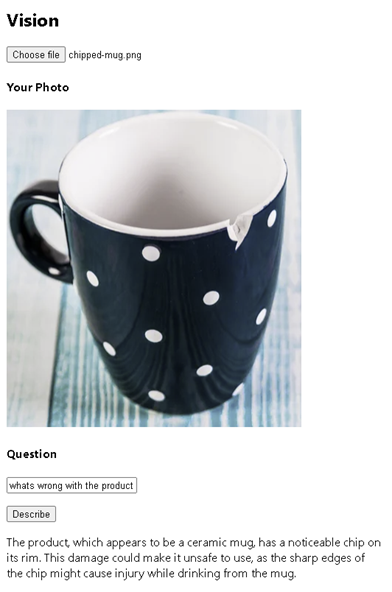Challenge 3: Vision
Product Image Analysis
Goal
Deliver a seamless and efficient customer service experience that enhances operational accuracy and accelerates processing times.
Challenge
Leveraging GPT-4o's vision capabilities for accurate analysis and verification of product photos. Reduces processing time but also ensures consistency and reliability in decision-making, ultimately enhancing the customer experience

Tips
Design a feature to utilise vision model to understand and extract information from image or photo.
There is a Vision page (apps\chatbot\pages\vision\Vision.tsx) on chatbot. The page has an image upload button to select a local image file, and a button to invoke AI Service and retrieve vision response.
Complete the visionApi function to send a user prompt together with a uploaded image, then receive the response that anlyzes certain features on the photo. The vision model will describe the content of the image.
-
Invoke GPT-4o using OpenAIClient using
image_urlattribute -
GTP-4o's details are on the setup page
-
Inspect the response payload of the call
-
Retrieve the response and display on the page
infoMore things to think about
- Reference an image directly that is accessible on the internet
- Define a system prompt that can be used as a template (i.e. product defect detection)
Basic Solution
Code snippet for above challenge
Don't Look! Have you tried to solve it yourself?
Your solution will be better than our sample answer!
The basic solution is provided below. Feel free to expand on it to make it more interesting!
import React, { useState } from "react";
import { trackPromise } from "react-promise-tracker";
import { usePromiseTracker } from "react-promise-tracker";
import { OpenAIClient, AzureKeyCredential, Completions } from '@azure/openai';
const Page = () => {
const { promiseInProgress } = usePromiseTracker();
const [selectedImage, setSelectedImage] = useState<File | null>(null);
const [imageBase64, setimageBase64] = useState<string>("");
const [imageText, setImageText] = useState<string>();
const [imageDesc, setImageDesc] = useState<string>("");
async function prcess() {
if (imageText != null) {
trackPromise(
visionApi(imageText, imageBase64)
).then((res) => {
setImageDesc(res);
}
)
}
}
async function visionApi(text, image): Promise<string> {
var messages =
[
{ "role": "system", "content": "You are a helpful assistant." },
{
"role": "user", "content": [
{
"type": "text",
"text": text
},
{
"type": "image_url",
"imageUrl": {
"url": `${image}`
}
}
]
}
];
const options = {
api_version: "2024-08-01-preview"
};
var openai_url = "https://arg-syd-aiapp1day-openai.openai.azure.com";
var openai_key = "<API_KEY>";
const client = new OpenAIClient(
openai_url,
new AzureKeyCredential(openai_key),
options
);
// ?api-version=2023-12-01-preview
const deploymentName = 'gpt4o';
const result = await client.getChatCompletions(deploymentName, messages, {
maxTokens: 200,
temperature: 0.25
});
return result.choices[0]?.message?.content ?? '';
}
function getBase64(event) {
let file = event.target.files[0];
let reader = new FileReader();
reader.readAsDataURL(file);
reader.onload = function () {
setimageBase64(reader.result);
};
reader.onerror = function (error) {
console.log('Error: ', error);
};
}
const updateText = (e: React.ChangeEvent<HTMLInputElement>) => {
setImageText(e.target.value);
};
return (
<div className="pageContainer">
<h2>Vision</h2>
<div>
<input
type="file"
name="myImage"
onChange={(event) => {
setSelectedImage(event.target.files[0]);
getBase64(event);
}}
/>
<br />
{selectedImage && (
<div>
<h4>Your Photo</h4>
<p>
<img
width={"400px"}
src={URL.createObjectURL(selectedImage)}
/>
</p>
<h4>Question</h4>
<input type="text" placeholder="(your question about the image)" onChange={updateText} />
<p>
<button onClick={() => prcess()}>Describe</button><br />
{
(promiseInProgress === true) ?
<span>Loading...</span>
:
null
}
</p>
<p>
{imageDesc}
</p>
</div>
)}
</div>
</div>
);
};
export default Page;